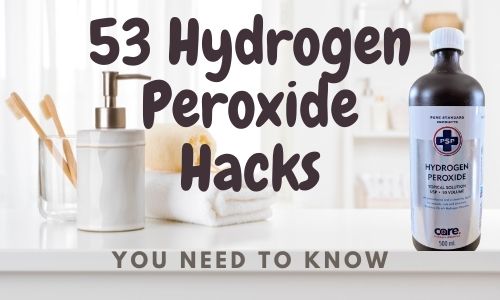Do you have a bottle of hydrogen peroxide in your house? I used to have one in my first aid kit. It sat there forever. It was used a few times to clean minor wounds, until I found out that wasn’t a good idea.
When I realized it had expired, I bought a new one and decided to research some practical hydrogen peroxide hacks so I didn’t waste another bottle. I had no idea how many uses there were for this little brown bottle.
Over the years, I’ve tried and tested these uses for hydrogen peroxide. I found them so effective that I wanted to share my favorite household hydrogen peroxide hacks with you so your bottle doesn’t expire!
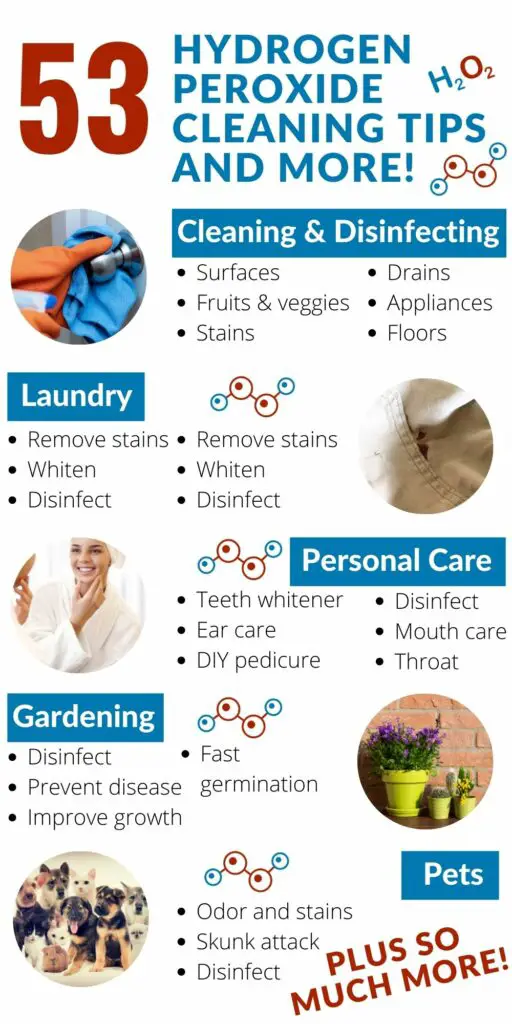
What is hydrogen peroxide?
Hydrogen peroxide is a chemical compound that has two hydrogen atoms and two oxygen atoms – H2O2. With a PH of 7, hydrogen peroxide is neutral like water.
PubChem describes hydrogen peroxide as an oxidizing agent with disinfectant, antiviral and anti-bacterial activities. It kills bacteria by destroying their cell walls.
Hydrogen peroxide is a colorless liquid and is widely available as a 3% solution in most drug and grocery stores. It can be used as an economical and effective household cleaner, laundry additive and disinfectant. It can even be used for plants.
H2O2 is used in a wide range of personal care products including toothpaste, mouthwash, professional hair dyes and bleaches.
RELATED POST: 3 Simple DIY disinfectant sprays that work!
As an Amazon Associate I earn from qualifying purchases. This means if you click on a link and buy something I’ve recommended, I get a small commission at no additional cost to you. You can see my full Disclosure Policy here.
How to store hydrogen peroxide
Hydrogen peroxide is unstable and decomposes quickly to oxygen and water when exposed to air and light. Unopened, hydrogen peroxide is much more stable and can last for up to 3 years in its original bottle.
Hydrogen peroxide should be stored in a cool, dark place. When you do open it, keep it in the original brown bottle which is designed to avoid exposure to light, heat and humidity.
Once you open the bottle, it begins to break down quickly and only lasts another few months. Expired hydrogen peroxide isn’t harmful but it’s not an effective disinfectant as it basically degrades to water.
You can check to see if hydrogen peroxide is still effective by pouring a small amount in your sink to see if it bubbles on contact with the metal drain. If it doesn’t, it’s time to buy a new one.
To use hydrogen peroxide for cleaning, simply use a clean spray nozzle on the original bottle and remove it and replace the original cap when you’re done.
RELATED POST: How to get motivated to clean when you’re overwhelmed by the mess
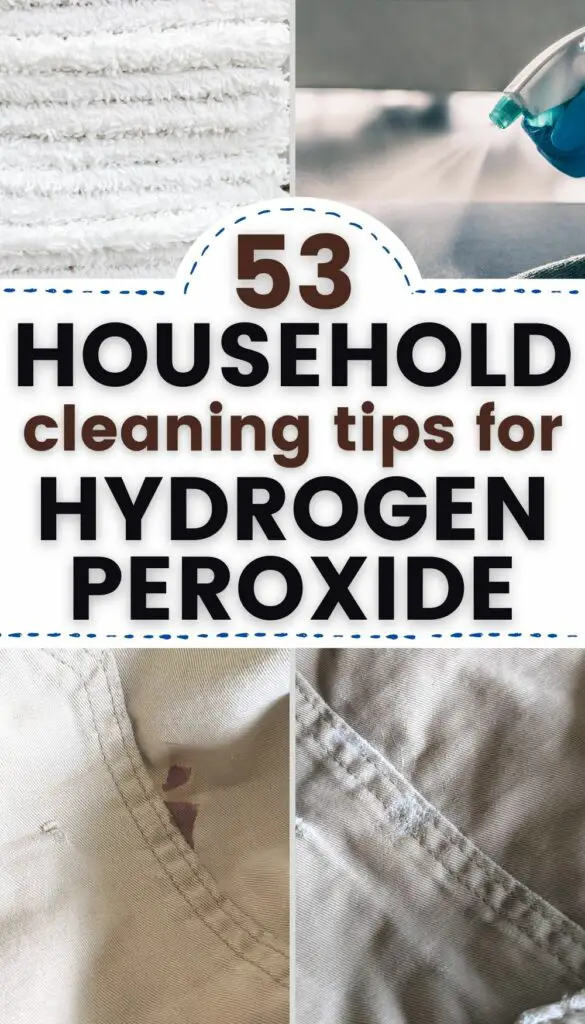
Hydrogen peroxide hacks for cleaning
For optimal disinfecting and sanitizing, I use the widely available 3% solution for the hydrogen peroxide hacks listed in this post.
To disinfect with hydrogen peroxide, it’s important to begin with a clean surface because you can’t disinfect something that isn’t clean. Otherwise the hydrogen peroxide will be working on breaking down the dirt and organic matter instead of disinfecting.
RELATED POST: 19 Household cleaning uses for Windex
Disinfect frequently touched surfaces
Use undiluted 3% hydrogen peroxide on surfaces such as doorknobs, tables, dining chairs, bathroom counters, faucets and knobs, toilets, light switches and handles.
Spray the hydrogen peroxide directly onto the clean surface and let sit for at least a minute. Then wipe clean with a clean, soft cloth or paper towels.
Disinfect food preparation areas
Disinfect your food preparation areas such as sinks, countertops, cutting boards and other areas prone to cross-contamination by first washing with simple soap and water. Then spray the dried surface generously with 3% hydrogen peroxide. Let sit for at least a full minute (longer is better) and then wipe clean. Rinse the area with fresh water afterwards.
RELATED POST: Dishwashing hacks for people who hate washing dishes
Wash fruits & veggies
Minimize dirt, pesticides and mold and keep fruits and vegetables fresh longer with hydrogen peroxide. Pour half a cup of hydrogen peroxide into a gallon of cold water. Plunge your berries or other fresh produce into the mixture and let sit for 5 minutes, moving them around with your hands to ensure coverage.
Rinse with fresh water. Make sure to thoroughly dry the items by spinning in a salad spinner or placing on clean towels then blotting. Store in paper towel lined containers or Ziplock bags.
RELATED POST: How to clean a really messy room fast
Remove organic stains and ink from natural stone surfaces
You can use hydrogen peroxide on granite, sandstone, slate or quartzite for organic stains like coffee, tea or sauces. You can also try it on light colored marble. Pour a 1/2 teaspoon of hydrogen peroxide directly on the stain. Let sit for a minute or two and remove with a damp cloth. Then rinse with clean water.
The same method can be used for magic marker, pen or other ink stains on light colored stone only.
It’s important to only use hydrogen peroxide for stain removal on natural stone, not as an everyday cleaner. Regular use can damage the finish.
Unclog sink drains
If you find your sink is draining slowly, try pouring a cup of baking soda down the drain, followed by a cup of hydrogen peroxide. Leave it to bubble and work on the clog for several hours, or even overnight if you can.
This eats away at any organic matter built up in the drain pipe. Hydrogen peroxide also keeps drainage pipes free of mildew and mold growth.
Once several hours have passed, pour very hot water into the drain until it runs clear.
RELATED POST: How to remove rust stains from bathtubs, sinks and toilets
Remove tea and coffee stains in cups and mugs
Pour enough undiluted hydrogen peroxide into the clean cup or mug to cover the stains. Let sit until the stain dissolves, then pour it into the next one. Rinse and dry.
RELATED POST: How to make your own all-purpose cleaner
Disinfect sponges and dishcloths
Soak your sponges and dishcloths in 3% hydrogen peroxide for 10 minutes. Rinse thoroughly with water and squeeze out any excess water. Let dry in direct sunshine if possible.
Sanitize trash can liners
Eliminate odors and breeding grounds for pests such as fruit flies by disinfecting your trash can liner with hydrogen peroxide. First, clean the liner from your garbage can with plenty of soap and hot water and dry (air dry in the sun if you can). Then generously spray hydrogen peroxide into the liner and let sit for 10 minutes or so. Dry with a clean paper towel.
Clean Glass Top Stove
Use a mixture of Dawn dish soap, baking soda and hydrogen peroxide to remove cloudiness and burnt on residue from your glass top stove. Substitute the citric acid in the article with hydrogen peroxide and follow the instructions.
RELATED POST: How to clean your glass stove top
Disinfect Fridge
As with food preparation surfaces, hydrogen peroxide is an effective sanitizer for your fridge. Remove all items in your fridge, wash with plain soap and water and dry with a clean cloth.
Spray undiluted hydrogen peroxide over all surfaces and let sit for 5 minutes. Wipe it off with a clean cloth to dry.
Disinfect reusable grocery bags
Reusable grocery bags are susceptible to bacteria and other germs because they hold food products that may leak into them. You can wash them with soap and hot water or run them through your washing machine and let air dry.
Once dry, generously spray all surfaces of the bag – especially the seams – with undiluted hydrogen peroxide and allow it to air dry again, preferably in the sun.
RELATED POST: Cleaning hacks for lazy people (like me)
Sanitize floors
If you have babies in your home, you know how important it is to have clean floors. To ensure your floors are safe for babies, and pets too, you can sanitize your floors with hydrogen peroxide.
After sweeping and mopping your floors, spray them with undiluted hydrogen peroxide and let it sit for a few minutes to do its sanitizing thing. Use a clean cloth or sponge to wipe up the spray and let it air dry. It will evaporate and leave no residue. It’s now perfectly sanitary for your tiny humans and pets to explore!
Sanitize your shower
After cleaning and drying your shower, spray it generously with undiluted hydrogen peroxide and wipe down with a clean cloth.
Clean Grout and Tiles
The PH of hydrogen peroxide is 7, making it neutral and safe to use on grout. Mix together 1/2 cup of baking soda and enough hydrogen peroxide to make a paste.
Use an old toothbrush to apply this paste to the grout, wait 10 minutes and then gently scrub the mold and mildew away with a stiff brush. Don’t forget to rinse.
To clean tiles, apply the paste to the tiles and let sit for a few minutes. Scrub with a sponge or stiff brush and then rinse with clean water.
RELATED POST: How to remove rust stains from your bathtub, sink or shower
Remove mold & mildew
To kill mold and mildew on floors, fixtures, walls and other surfaces, spray undiluted hydrogen peroxide on the affected area. Let it sit for 10 minutes and then scrub with a stiff brush. Wipe away any remaining mold or mildew with a cloth, rinse with fresh water and dry.
Clean Glass & Mirrors
Spray the surface with undiluted hydrogen peroxide. Wipe clean with newspapers for a streak-free shine.
Clean burnt pots, pans and baking sheets
Sprinkle baking soda liberally all over the surface of the pan, then spray enough undiluted hydrogen peroxide to make a paste. Make sure to cover all burnt surfaces. Let sit overnight.
The next day, use a scraper to scrape off all the paste and discard. Wash the pan in hot soapy water with a scrub brush. The remaining stains will be easily removed. Rinse and dry.
Disinfect coolers and insulated cups
It’s important to regularly disinfect coolers and insulated travel cups as they are used for food and drink. First, wash with soapy, hot water and rinse. Then generously spray the hydrogen peroxide into the item. Let sit for 15 minutes then leave to thoroughly air dry, preferably in direct sunlight if possible.
Disinfect your dishwasher
To disinfect your dishwasher, wipe down the interior of your dishwasher with a sponge. Make sure to remove all organic matter. Pour a cup of hydrogen peroxide into the bottom of your dishwasher and run the dishwasher empty on its hottest setting. Skip the drying cycle.
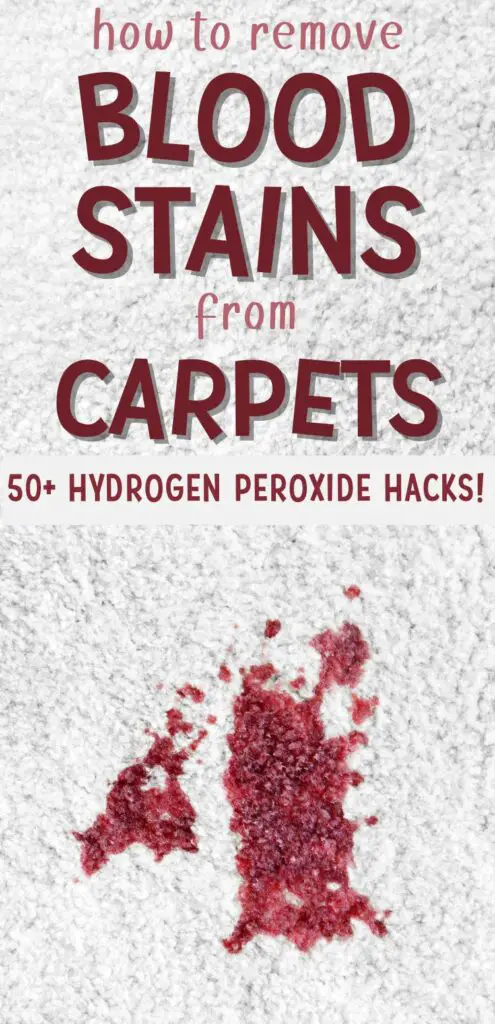
Remove organic carpet and furniture stains
Stains like blood, urine, vomit, wine and coffee can be removed from carpet and furniture with hydrogen peroxide. Remove any solid material and blot what you can with paper towels or a cloth before generously spraying the undiluted hydrogen peroxide onto the stain. Let sit until the stain disappears.
If you can expose the area to sunlight or other UV light, it will help to speed up the stain removal process.
If the area dries while waiting, spray more hydrogen peroxide until it is completely wet again, but be careful not to saturate the pad underneath.
If you’ve sprayed the area a few times and waited hours and the stain is still there, it’s time to call a professional.
Sanitize toys
Soak clean toys in undiluted hydrogen peroxide for at least 15 minutes. Air dry.
Prevent mold in humidifiers
To prevent mold growth in your humidifier, add 1/4 cup of hydrogen peroxide each time you add water.
Hydrogen peroxide to sanitize your pool or hot tub
Hydrogen peroxide combined with UV light from the sun provides disinfection and oxidization equal to or greater than chlorine, without the need for additional chemicals. You can shock your pool or hot tub with hydrogen peroxide by adding 1 cup (250 ml) of 35% hydrogen peroxide for every 250 gallons (1000 liters) of water. To maintain a sparkling clean pool or hot tub, keep hydrogen peroxide levels between 50 – 90 ppm using these hydrogen peroxide test strips. Remember to run your pump every night and change the filter every two weeks.
RELATED POST: Time saving cleaning hacks for people who hate cleaning
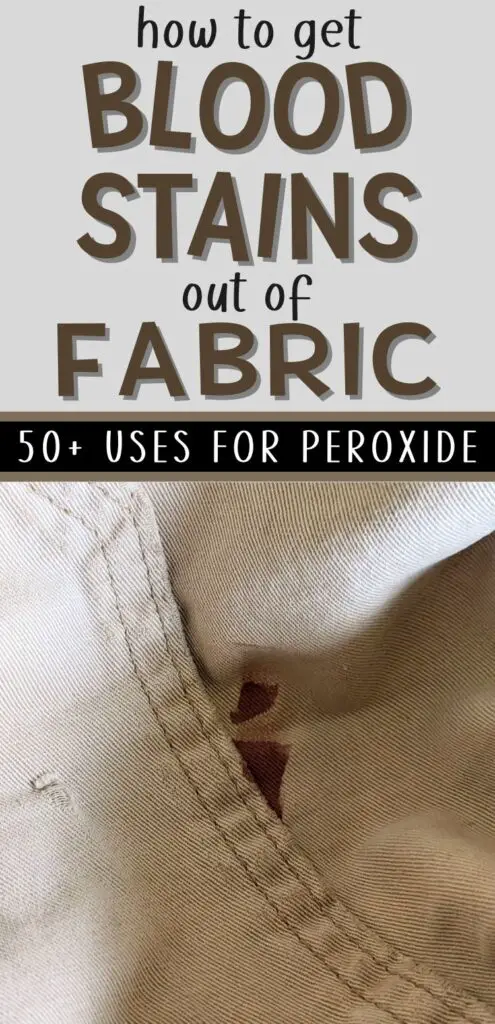
Hydrogen peroxide uses for laundry
Hydrogen Peroxide is an effective alternative to bleach. It’s also more environmentally friendly and not as toxic to humans. It’s an amazing stain remover and all round whitener for laundry.
Does hydrogen peroxide bleach clothes?
3% hydrogen peroxide, which is what is usually sold at retail stores, won’t bleach your clothes. However, 10% or higher hydrogen peroxide may bleach them. Hydrogen peroxide is an oxygen bleach that is usually considered safe for colored clothes. It doesn’t contain chlorine and it won’t ruin most fabrics, although you should avoid using it on silk or leather.
Does hydrogen peroxide stain clothes
Hydrogen peroxide may stain clothes made with synthetic fibers, although it’s completely safe for natural fabrics like cotton. When working with synthetic fabrics, stick with 3% solution which should be safe for all fabrics. Test some hydrogen peroxide on a small, inconspicuous area of the fabric first before using it on the entire garment. Always rinse the stain with cold water before applying peroxide.
Remove organic stains from clothing
Use hydrogen peroxide for blood stains! You can also remove other organic stains such as sweat, urine, vomit, wine and coffee from clothing by thoroughly rinsing the area with cold water, then spraying the stain with undiluted hydrogen peroxide. Let sit until the stain fades, soaking again if necessary. Blot, then rinse with cold water to avoid bleaching or yellowing the fabric.
Keep your whites white
Instead of bleach, add a cup of hydrogen peroxide to your white loads to keep them bright and white. Using bleach with hard water can cause whites to stain because hard water may contain iron particles which oxidize or rust when combined with chlorine bleach.
Remove armpit and other yellow staining
To remove armpit stains or yellow tinge from lace curtains or tablecloths, pour hydrogen peroxide into a container just large enough to hold the item. Pour enough to ensure it’s completely soaked, and soak for at least an hour. Rinse in cold water and air dry, preferably in bright sunshine.
Remove mold and mildew from shower curtains
Remove mold and mildew from shower curtains, pour a cup of hydrogen peroxide into your washing machine, along with your usual laundry soap. Place a towel, along with the shower curtain in the machine and run it as usual.
The peroxide will remove the mold and mildew and the towel will provide extra agitation to ensure the curtain comes out clean.
DIY OxiClean oxygen cleaner
Combine 1 part washing soda with 1 part hydrogen peroxide to whiten and brighten your laundry – even colors! You can also spray the mixture on to spot remove stains or to soak heavily soiled items.
Remove musty smell from towels and dish cloths
To get that musty smell out of wet towels or dishcloths that sat too long, pour a cup of hydrogen peroxide into the load with your regular laundry soap. Hang dry in bright sunshine if you can. Otherwise dry them on the hottest setting on your dryer.
Spot clean mattress stains
You can spot clean organic mattress stains by spraying the stain generously with undiluted hydrogen peroxide. Let it sit until the stain is lifted.
If the area dries before the stain is gone, spray it again and let sit. If this still doesn’t lift the stain, you can try a drop or two of Dawn dishwashing liquid mixed with the hydrogen peroxide to add an additional stain removing boost. Use a stiff brush to scrub the stain, then rinse with clean water. Blot up any excess liquid and allow it to air dry.
Hydrogen peroxide is also effective at controlling dust mites. Follow the same process and let air dry. Vacuum when dry.
Disinfect your washing machine
Wipe down your washing machine thoroughly with a damp cloth, ensuring you remove all dirt, hair and other organic matter. Pour 2 cups of hydrogen peroxide into your washing machine and run it through the hottest cycle.
Hydrogen peroxide hacks for personal care
Hydrogen peroxide uses for teeth and mouth (oral care)
Disinfect your toothbrush
If you have recently been ill, you can disinfect your toothbrush using hydrogen peroxide to prevent reinfection. Soak the head of your toothbrush in just enough hydrogen peroxide to cover it for at least 15 minutes for maximum sanitization.
Disinfect retainers or mouth guards
Soak your retainer or mouth guard in undiluted hydrogen peroxide for 15 minutes to sanitize and disinfect your mouth appliance. Remove the appliance and rinse with fresh water, then air dry.
Clean, disinfect and whiten dentures
Rinse the dentures with clean water and brush away any debris with a toothbrush. Place the dentures into a bowl filled with a 50/50 mixture of hydrogen peroxide and water. Use enough to completely cover the dentures. Let sit a minimum of 30 minutes up to overnight, depending on how stained they are. Rinse again thoroughly before using.
Whiten your teeth
Dentists use a high percentage of hydrogen peroxide for their professional teeth whitening. For a DIY teeth whitening solution, you can use 3% hydrogen peroxide to brighten your teeth, along with baking soda which is a mild abrasive with whitening properties. There are many commercial whitening toothpastes that contain both these ingredients.
Combine 1 teaspoon of baking soda with just enough hydrogen peroxide to make a paste. Use the paste to brush your teeth up to 3 times a week. It’s not advised to use this mixture everyday as it can erode the enamel on your teeth if used too often. Discontinue use if your teeth become sensitive.
Canker sores
These small, painful blisters inside your mouth can make it difficult to eat and make you miserable. Rinse your mouth with undiluted hydrogen peroxide for 60 seconds to eliminate bacteria in the mouth, prevent infection and promote healing. Spit it out and rinse your mouth with water.
Strep or other bacterial throat infection
Strep is a bacterial infection in your throat. Gargle with a mouth full of undiluted hydrogen peroxide for 60 seconds or as long as you can stand. The hydrogen peroxide will help kill that throat bacteria and promote healing. Rinse your mouth with water after spitting out the hydrogen peroxide.
Eliminate bad breath
Halitosis, or bad breath, is frequently caused by bacteria in the mouth. It could be from a buildup of plaque on your teeth from food particles or from pockets of bacteria in your gums.
First, thoroughly brush your teeth – don’t forget your tongue – and floss your teeth. Then swish a mouthful of undiluted hydrogen peroxide around your mouth for at least 60 seconds and spit it out. Then rinse your mouth with fresh water. This will reduce the level of bacteria on your mouth and freshen your breath.
Hydrogen peroxide uses for skin
Hydrogen peroxide used to be recommended as an antiseptic on the skin to prevent infection of minor wounds. While it is effective for killing bacteria, it is indiscriminate and can kill cells that assist in healing as well. It can also irritate the skin and cause redness, inflammation and even blistering. It is not advised to use hydrogen peroxide on the skin very frequently for these reasons.
If you do use hydrogen peroxide on your skin to disinfect small cuts or scrapes, don’t leave it on too long. Make sure to rinse with plenty of clean water afterwards to avoid skin irritation.
Hydrogen peroxide uses in ear
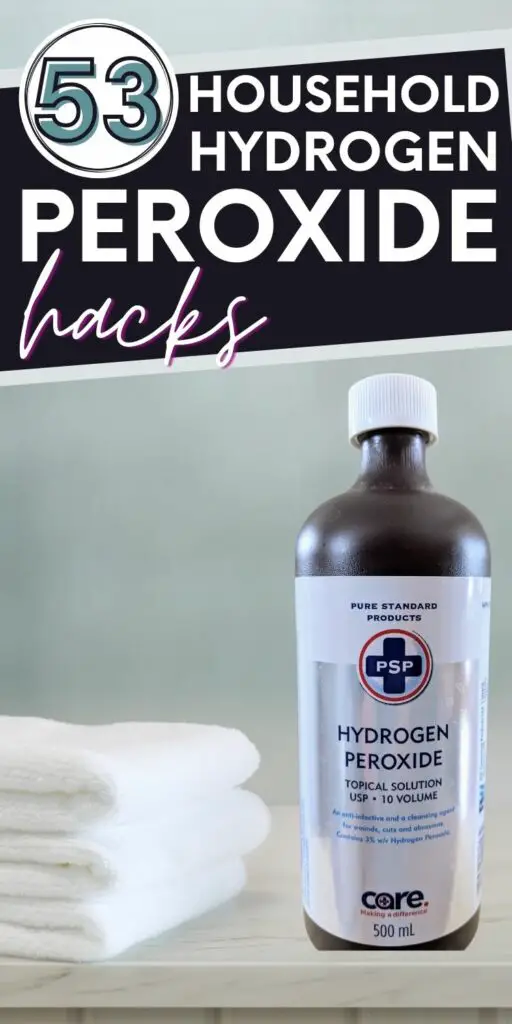
Soften and remove ear wax
To use hydrogen peroxide to remove ear wax, lie down and turn your head with the affected ear up. Instill a few drops in your ear with an ear dropper. Keep your head in place to prevent drips.
Allow the drops to sit for up to 5 minutes. If you feel any irritation or burning, stop immediately, rinse your ear thoroughly with fresh water and dry completely.
After the 5 minutes are up, place a tissue over your ear and sit up. Let the hydrogen peroxide drain into the tissue. Gently rinse your ear with an ear bulb syringe filled with tepid water to remove earwax and rinse the hydrogen peroxide out of your ear canal. When you’ve finished rinsing, dry your ears thoroughly.
Prevent swimmer’s ear
Instill a few drops of hydrogen peroxide into the dry ear while you are lying on your side. Let it sit for 5 minutes and then let it drain out into a tissue. Rinse the ear with fresh water.
Dry the ear thoroughly with a towel or a hair dryer on a low setting. It is very important that you keep your ears dry to avoid swimmer’s ear.
Uses for hydrogen peroxide on feet
DIY shoe deodorizer
For an easy and effective DIY shoe deodorizer spray, use hydrogen peroxide in a spray bottle. Open the shoes as much as you can to provide more spraying surface and saturate the interior of the shoes with the hydrogen peroxide spray. Let dry completely (overnight if you can) before putting the shoes back on your feet.
Hydrogen peroxide can kill a wide variety of bacteria and fungi and neutralize the odor in your shoes. Eliminating the microbes will help eliminate the odor.
RELATED POST: DIY shoe deodorizer: 16 ways to refresh stinky shoes
DIY pedicure soak
The bubbling and foaming properties of hydrogen peroxide make it ideal for removing dead skin cells. Soak feet in a 50/50 solution of warm water and hydrogen peroxide for 15-20 minutes to soften calluses and dry, cracked heels.
Next, use a pumice stone to remove the dry dead skin off the bottoms and heels of your feet and smooth any calluses.
Then dry your feet completely, making sure to dry in between your toes. Slather on some O’Keefe’s Healthy Feet Foot Cream and then put some socks on while the cream gets absorbed. Keep them on overnight if you can and then enjoy your smooth, soft feet.
RELATED POST: How to clean flip flops (even when they stink)
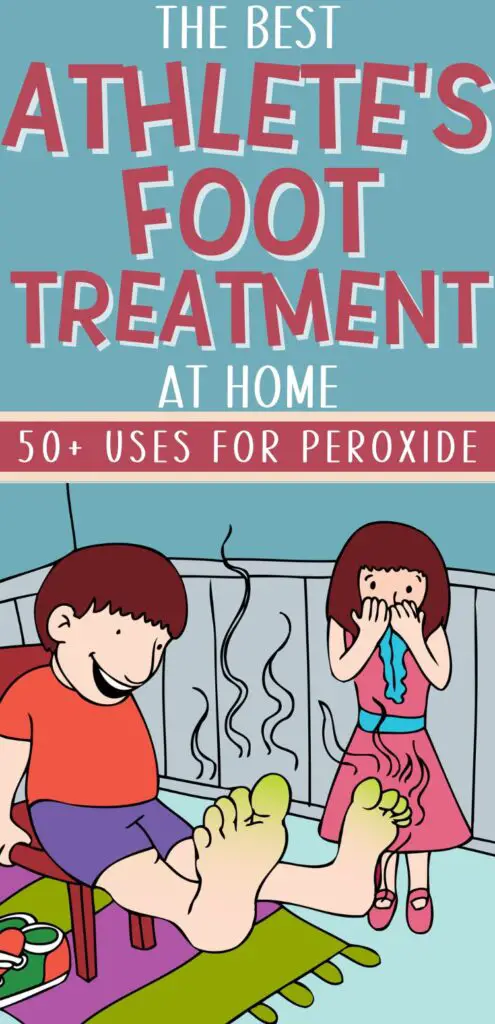
Athletes foot treatment at home
Athlete’s foot is a fungal skin infection that usually starts between the toes. It causes a scaly, itchy rash that burns.
Hydrogen peroxide can kill athlete’s foot fungus. It’s the easiest athlete’s foot treatment at home. Just pour undiluted hydrogen peroxide directly into a basin and soak your foot in it. Let it bubble for 5-10 minutes.
Rinse your foot and make sure it’s completely dry between your toes. Do this 2-3 times a day until the symptoms subside.
Beauty hydrogen peroxide hacks
Whiten yellowed nails
Do you have yellow or stained nails? Hydrogen peroxide can be used to easily whiten yellow or stained nails. Simply combine 1 teaspoon of baking soda with 2 teaspoons of hydrogen peroxide in a small container (I used a shot glass).
Stir the mixture with the affected nail and soak the nail for 3-5 minutes, until the stain is gone. For stubborn stains, use a nail brush to remove any remaining stain.
Sanitize makeup brushes and applicators
Makeup brushes and applicators that are used regularly become petri dishes. They harbour dead skin cells and bacteria and need to be cleaned frequently.
To clean makeup brushes and applicators, pour equal parts warm water and hydrogen peroxide into a bowl. Add a drop of Dawn dish soap and gently mix.
Place your makeup brush or applicator into the cleaning solution and agitate with your fingers. Make sure to run your fingers all around the brush or applicator to get any dirt and debris out. Let it sit in the solution for 5-10 minutes.
Rinse with cool water and let air dry on a clean towel.
RELATED POST: 42 Incredible uses for Dawn dish soap
Hair lightener
Yes, you can lighten your hair with hydrogen peroxide. But it’s a good idea to test a few strands first to see if you like the result.
Start with damp hair. Dip a new toothbrush into a bowl of hydrogen peroxide. Use the toothbrush to coat the strands of hair. Wait 15 minutes, then rinse with cool water.
If you like the results of this test, here’s more information from a pro about How To Bleach Your Hair With Hydrogen Peroxide
Deodorant
Bacteria under the arms causes odor. Hydrogen peroxide kills bacteria. To use hydrogen peroxide as a deodorant, simply spray some 3% hydrogen peroxide under your arms. Let it dry and then get on with your day.
Sanitize nail clippers, tweezers and other beauty tools
To sanitize beauty tools such as nail clippers, tweezers, etc., pour undiluted hydrogen peroxide into a bowl. Place the item in the bowl, make sure it is completely covered, and let sit for 15-30 minutes. Rinse in cool water and air dry on a clean towel.
Hydrogen peroxide hacks for plants and garden
Disinfect pots, tools and potting benches
To disinfect clean pots and other garden tools, spray undiluted hydrogen peroxide liberally all over the item. Let sit for at least 5 minutes, then put out in the sun to dry or simply air dry.
Prevent fungal diseases and pests
To prevent fungus and pests on plants, mix 1 tablespoon of hydrogen peroxide with 1 cup of water in a spray bottle. Add a few drops of mild liquid soap to help the mixture stick to the plant. This mixture will degrade quickly, so only make as much as you need.
Spray the affected areas of your plants with the hydrogen peroxide mixture, taking care to get the underside of leaves as well. To prevent burning the leaves, never apply in full sunlight
Improve plant growth
To boost the growth of your plants, mix ½ cup of hydrogen peroxide to a gallon of water. Pour the solution onto the roots of your plants. Try to avoid getting the solution on leaves or stems and don’t apply in direct sunlight.
Germinate seeds
Mix a teaspoon of hydrogen peroxide with a cup of water. Wrap the seeds in cheesecloth and place the seeds in the solution and let sit for 5 minutes. Rinse the seeds under running water and germinate as usual.
Hydrogen peroxide uses for pets
Induce vomiting
If you find yourself in an emergency situation where your dog has ingested something toxic, hydrogen peroxide can be used to induce vomiting. It’s crucial that you speak with your veterinarian before attempting this as there are many situations where inducing vomiting can lead to worse outcomes.
To induce vomiting in a pet, administer 1 teaspoon of hydrogen peroxide per 5 lbs of weight up to a maximum of 3 tablespoons for larger pets. Use a syringe to administer to the back of the tongue to help ensure your pet swallows it.
Pet urine odor and stains
Did you know that hydrogen peroxide is the active ingredient in most commercial products that claim to eliminate pet urine odors?
Soak towels or clothing in a bowl of undiluted hydrogen peroxide for up to 30 minutes, then wash and dry as usual.
For carpeting and floors, blot up urine with a cloth or paper towel. Saturate the area with undiluted hydrogen peroxide with a spray bottle and let sit for 20 minutes. Blot the area again until no excess moisture remains and then leave to air dry.
Skunk attack
If your pet ends up on the unfortunate end of a skunk, you can remove the odor using hydrogen peroxide.
Mix 1 quart of undiluted hydrogen peroxide, ¼ cup of baking soda and 1 teaspoon of liquid hand soap or body wash. Immediately apply the mixture to your pet and work through. Let sit for 5 minutes, then rinse clean with running water. If your pet was particularly close to the skunk, you may have to repeat this process.
Disinfect litter boxes
Empty your litter box and wash it with soapy water. Spray undiluted hydrogen peroxide liberally all over the interior surface of the litter box. Let sit for 15 minutes. Dry the litter box and fill it as usual.
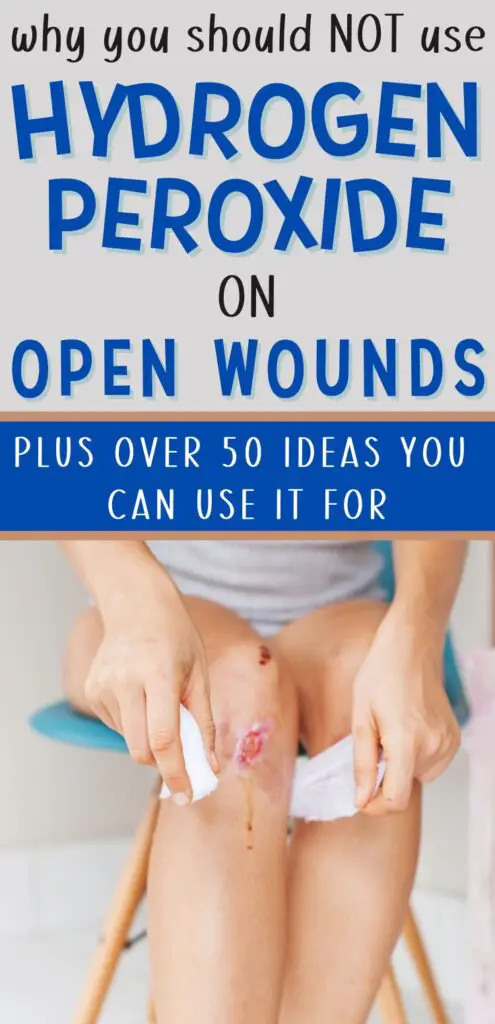
What should you not use hydrogen peroxide for?
- While ingesting small amounts of hydrogen peroxide may only produce mild effects, ingesting large amounts can lead to severe complications and can even be fatal in some cases.
- Hydrogen peroxide was previously used for minor cuts, scrapes and burns, but you shouldn’t use hydrogen peroxide on open wounds. Its bacteria, fungi, yeast, virus, and spore killing properties also kill healthy cells that promote healing. It can also cause skin irritation, inflammation and redness. It is no longer recommended for use on skin.
- Never use peroxide on natural fibers like wool or cotton. Severe damage and bleaching can occur.
- Do not regularly use undiluted hydrogen peroxide on natural stone as regular use can damage the finish. Only use it to remove stains.
What should you not mix with hydrogen peroxide?
Hydrogen peroxide and vinegar
You should NEVER mix hydrogen peroxide with vinegar. It creates peracetic acid which is corrosive and can irritate your skin, eyes, nose, throat and even your lungs.
Hydrogen peroxide and baking soda
While you can mix hydrogen peroxide and baking soda together for immediate use, never store it in a closed container. The resulting buildup of carbon dioxide can cause the container to explode, leak or spray when opened.
Hydrogen peroxide has so many uses! From sanitizing to stain removal; lightening your hair to whitening nails; and pet care to gardening, these hydrogen peroxide hacks have definitely made my life easier. I hope it makes your life a little easier too.
Let us know in the comments if we’ve missed your favorite use for hydrogen peroxide!

